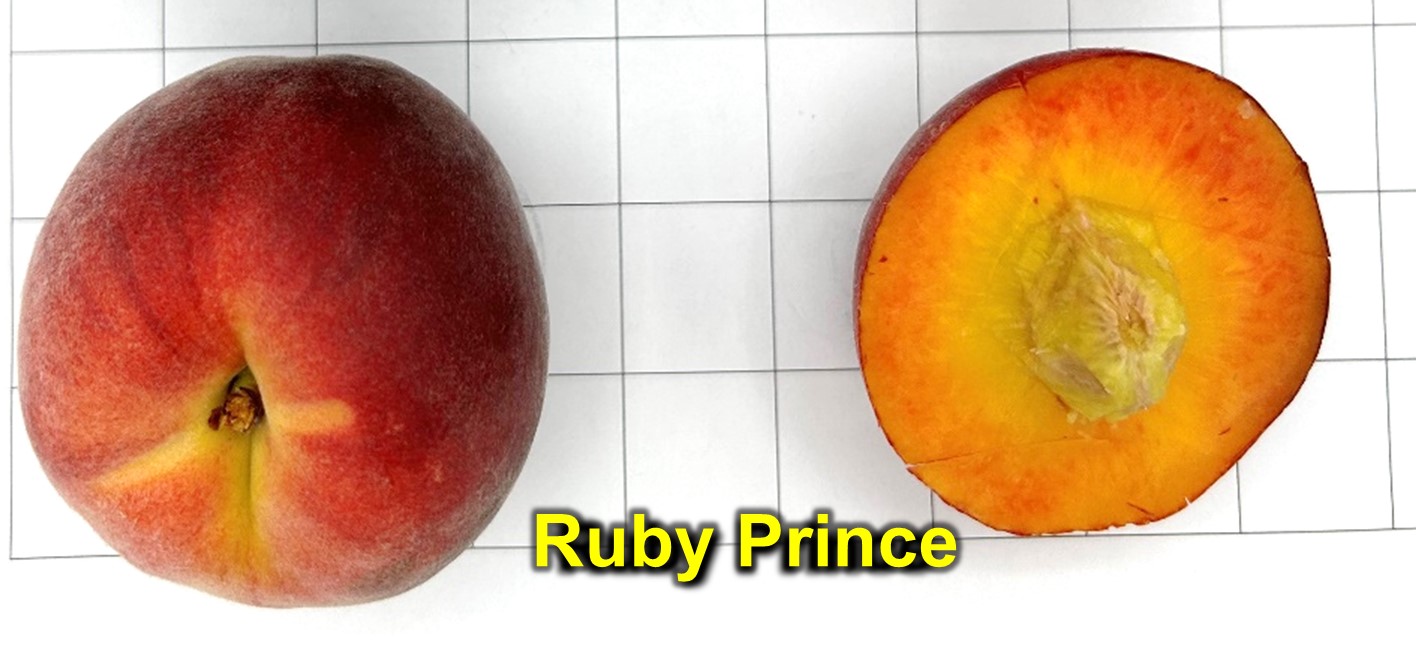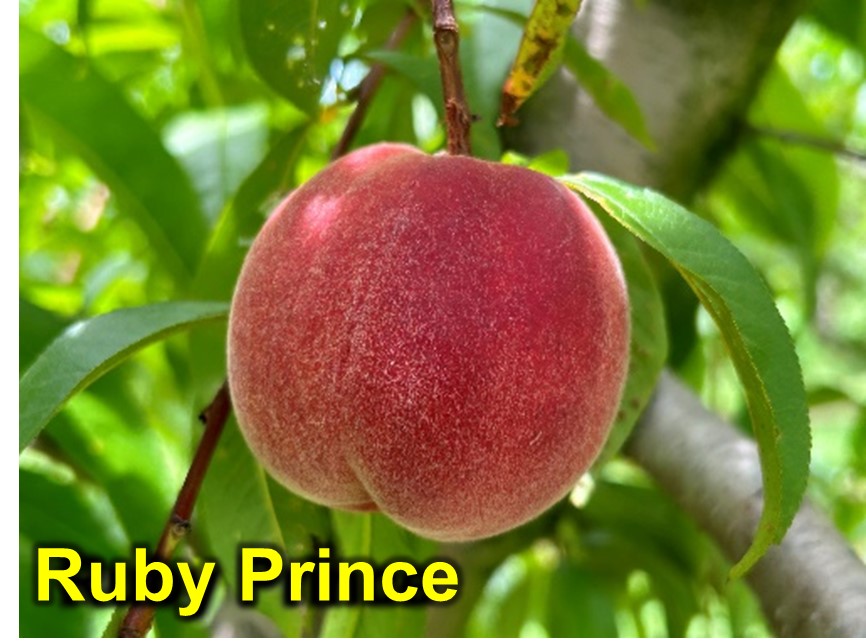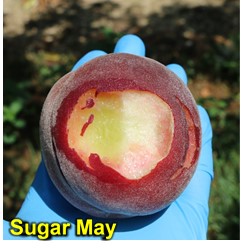There are four excellent, yellow and white-fleshed nectarine varieties harvested during mid-July. These varieties were developed at the Rutgers Fruit Breeding program and evaluated over the years at multiple Southern New Jersey locations. The ripening days could be a few days later for central and northern New Jersey. [Read more…]
Tree Fruit Edition
Seasonal updates on insects, diseases, weeds, maturity dates and cultural practices impacting only tree fruit.
Subscriptions are available via EMAIL and RSS.
Mid-July Nectarine Varieties for NJ – Silvergem, Silverglo, Easternglo, and Avalon
Mid-July Peach Varieties – Gala, PF 8 Ball, Summer Serenade, July Rose, and PF Lucky 13
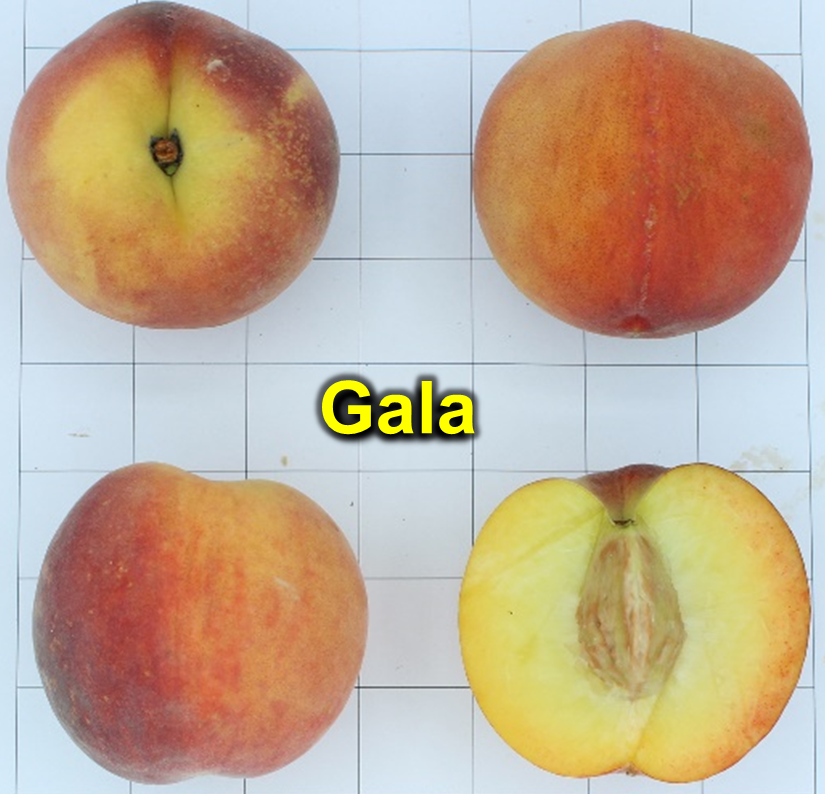 GALA is a medium to medium-large, globose, 70-90% scarlet red over yellow-orange ground color, yellow-fleshed, semi-freestone peach ripening July 11-15, about a week after the Sentry. The flesh is firm, with a sweet and mildly tangy flavor. The tree is vigorous and moderately productive. Note that these varieties were evaluated in southern New Jersey; as a result, the harvest dates could be a few days later for the Central and Northern New Jersey orchards.
GALA is a medium to medium-large, globose, 70-90% scarlet red over yellow-orange ground color, yellow-fleshed, semi-freestone peach ripening July 11-15, about a week after the Sentry. The flesh is firm, with a sweet and mildly tangy flavor. The tree is vigorous and moderately productive. Note that these varieties were evaluated in southern New Jersey; as a result, the harvest dates could be a few days later for the Central and Northern New Jersey orchards.
Challenges: Gala is a beautiful peach in a great season, but the size and yield could be highly variable. Split pits are a problem even in a normal year, and the first pick may have significant split pits. Fruit has medium susceptibility to bacterial spot.
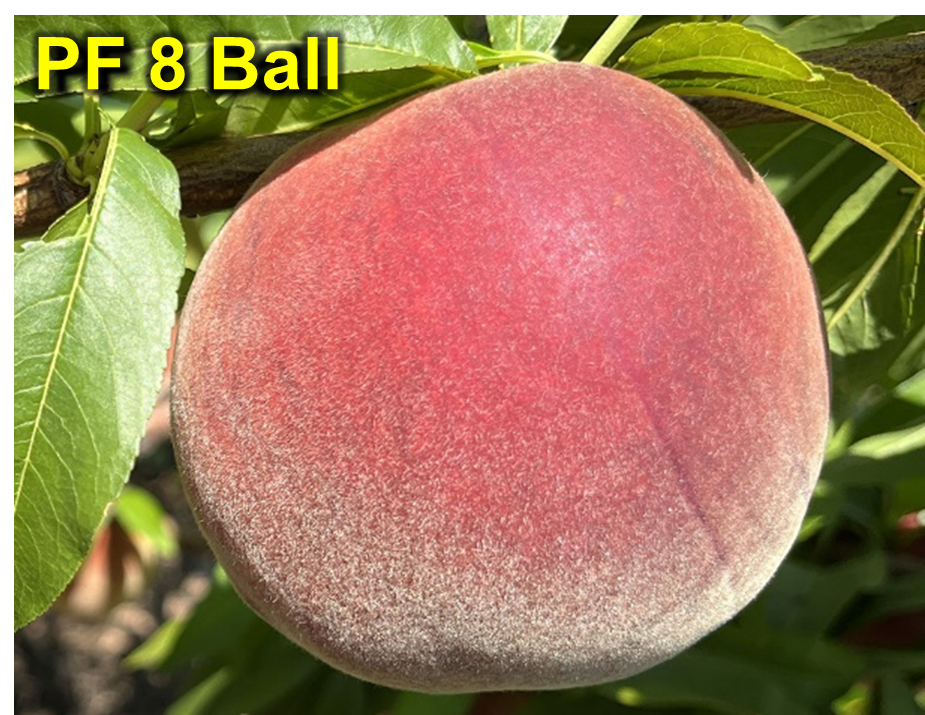 FLAMIN FURY® PF#8 BALL is a large, globose, 70-90% crimson red over greenish-yellow ground color, yellow-fleshed semi-clingstone peach with prominent suture groove, ripening during July 13-18. The fruit is firm, with melting, sweet, juicy flesh, and has a sweet and tangy flavor. The tree is spreading, vigorous, and productive, with medium susceptibility to bacterial spots. A promising variety because of its color and size. A good option to replace Gala peach.
FLAMIN FURY® PF#8 BALL is a large, globose, 70-90% crimson red over greenish-yellow ground color, yellow-fleshed semi-clingstone peach with prominent suture groove, ripening during July 13-18. The fruit is firm, with melting, sweet, juicy flesh, and has a sweet and tangy flavor. The tree is spreading, vigorous, and productive, with medium susceptibility to bacterial spots. A promising variety because of its color and size. A good option to replace Gala peach.
SUMMER SERENADE is a medium-large, globose to ovate, attractive, 50-70% crimson red over yellow-green ground color, yellow-fleshed, semi-clingstone peach ripening from July 13-16, approximately 11 days before Redhaven. The flesh is firm with fair to good flavor. The tree is moderately vigorous and productive, with low susceptibility to bacterial spot. Summer Serenade has a better size than Garnet Beauty and PF 7, with a significant suture groove and flavor like Garnet Beauty.
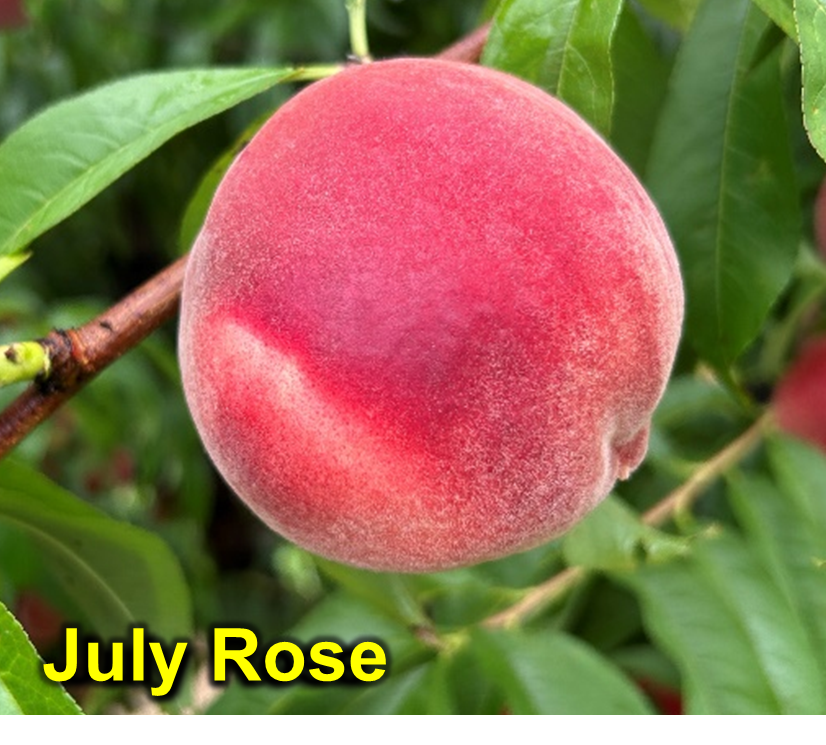 JULY ROSE is a popular white fleshed peach with excellent firmness, cling stone, and low fuzz. Fruit is large and attractive, and ripens between Sugar May and White Lady from 15-20 July. Fruit is always very sweet and sub-acid. It has good fruit and leaf resistance to bacterial leaf spot. Even poorly thinned trees tend to produce large-sized fruit. Moderate fruit or bloom thinning will be required to optimize size and quality. Fruit hangs well and has better cold-hardiness than other white varieties.
JULY ROSE is a popular white fleshed peach with excellent firmness, cling stone, and low fuzz. Fruit is large and attractive, and ripens between Sugar May and White Lady from 15-20 July. Fruit is always very sweet and sub-acid. It has good fruit and leaf resistance to bacterial leaf spot. Even poorly thinned trees tend to produce large-sized fruit. Moderate fruit or bloom thinning will be required to optimize size and quality. Fruit hangs well and has better cold-hardiness than other white varieties.
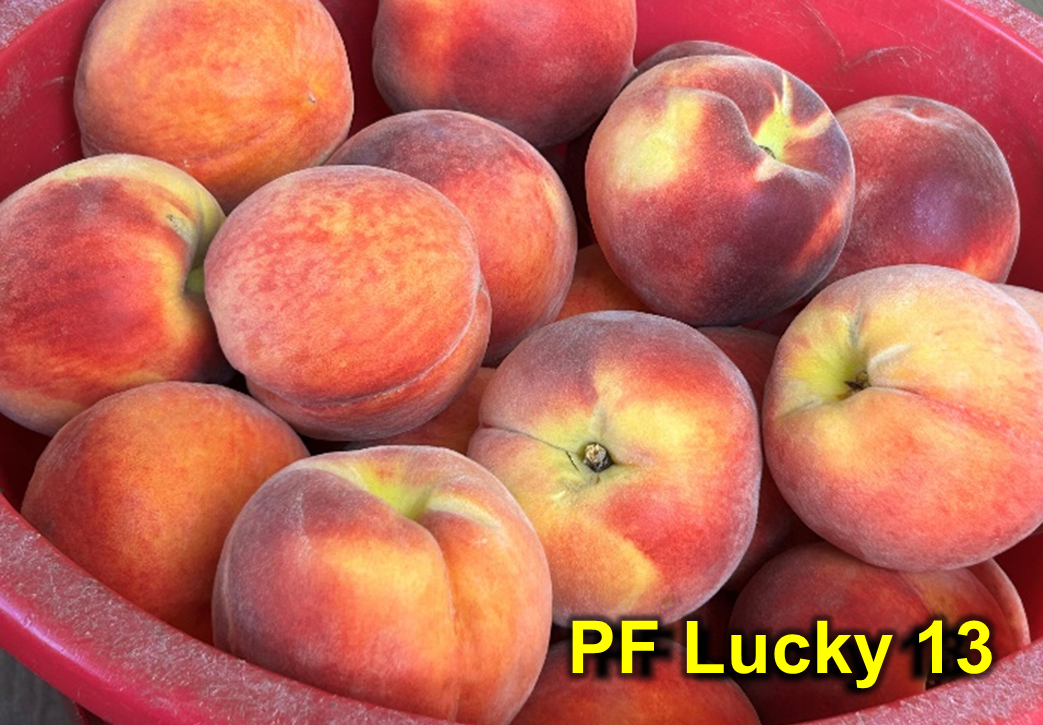 Snowbrite is a good white-fleshed peach that ripens a few days after July Rose but is highly susceptible to bacterial spots. Scarlet Pearl is another good white-fleshed peach. However, it is a cold, tender variety and produces split pits.
Snowbrite is a good white-fleshed peach that ripens a few days after July Rose but is highly susceptible to bacterial spots. Scarlet Pearl is another good white-fleshed peach. However, it is a cold, tender variety and produces split pits.
FLAMIN FURY PF LUCKY 13 is a large, globose to slightly ovate, heavy scarlet red over orange-yellow ground color, yellow-fleshed, freestone peach ripening near or earlier than Redhaven. The flesh is crunchy, firm, and sweet and tangy. The tree is vigorous and productive, with slight drop and inking tendencies and low to moderate susceptibility to bacterial spots. This very attractive peach has also shown good size and minimal splits.
Previous related articles
- Early July Peach Varieties: https://plant-pest-advisory.rutgers.edu/early-july-peach-varieties-sentry-glenglo-ruby-prince-garnet-beauty-and-sugar-may/
- Late June Peach Varieties: https://plant-pest-advisory.rutgers.edu/late-june-peach-varieties-for-new-jersey-new-and-standard/
Fruit IPM Report July 21, 2025
Peach:
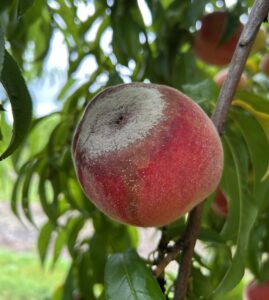
Figure 1. Brown rot on ripening peach fruit.
Diseases: Brown rot: Brown rot is appearing in ripening fruit throughout the state (Figure 1).
Highly effective rot materials such as DMI’s (FRAC group 3) and Strobilurins (FRAC group 11) should be applied beginning 3 – 4 weeks prior to harvest. See the NJ Commercial Tree Fruit Production Guide for more information.
Tarnished Plant Bugs; and Other Cat-facing Insects: Tarnished plant bug and stink bugs are active and present at moderate to high levels in some orchards. The percent fruit injury observed remains low (average <1%).
Oriental Fruit Moth: A biofix point for OFM was set on 4/2 for southern counties and 4/17 in northern counties. See below for timings for third generation.
|
|||||||||||||||||||||||||
Scale Insects: Second generation White Peach Scale crawlers should emerge sometime this week or next. Second generation San Jose Scale crawlers emerge about 7/17 +/- 8 days. Esteem is a good scale material that has a 14-day PHI for stone fruit. Centaur is also effective, has a 14-day PHI and can be used only once during the growing season. Venerate has shown efficacy as a pre-harvest treatment against scale and has a 0-day PHI. If using Venerate to control scale insects, make 2 applications 7 days apart starting a week after crawler emergence.
Japanese Beetles: Japanese beetles and June bugs have been observed feeding on fruit in southern counties. Adults are attracted to ripening fruit. Insecticides that are effective against Japanese beetles and june bugs are products that contain imidacloprid (Admire pro and Leverage 360), Danitol, and Sevin.
Apples and Pears:
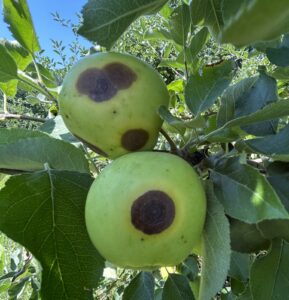
Figure 2. Bitter rot infection on apple.
Diseases: Various rots but mostly bitter rot is present in orchards throughout the state (Figure 2).
Research has suggested products such as Merivon, Luna Sensation, Inspire Super, Omega, and Aprovia are effective rot materials to be alternated with broad-spectrum fungicides such as captan and ziram. Phosphorous acid products such as Prophyt or Rampart can be added to captan sprays to improve control.
Brown Marmorated Stink Bugs: Brown Marmorated Stink bugs are being captured at low levels in orchards statewide. Both adults and nymphs are present. See the NJ Tree Fruit Production guide for effective materials.
Codling Moth (CM): Second generation timings are updated below. Trap captures continue and increased slightly in some southern county orchards last week. Additional applications should be made if trap captures exceed 5 moths/trap.
| Codling Moth Degree Day Timing – Second Generation | ||||||||
| Application and Insecticide Type | ||||||||
| County Area | Biofix | Rimon:
75-100DD + 14-17 days later
|
Intrepid
1150 + 1450 DD Diamides – Altacor, Voliam mixes: (150-200 DD) |
Madex
1250 DD + every 7-9 days during brood hatch (later if first spray is an IGR) |
Standard Insecticides – Delegate, Avaunt, OP’s, carbamates, pyrethroids
1250 DD + 1550 DD
|
|||
| DD | 1150 | 1450 | 1250 | 1250 | 1550 | |||
| Southern | April 28 | N/A | N/A | past | past | past | past | past |
| Northern | April 30 | N/A | N/A | past | past | past | past | past |
Scale Insects: See earlier statement on scale insects in peaches.
Pear: Pear psylla nymphs have been observed in high numbers feeding on new growth in some orchards. Options for control include Movento (IRAC group 23), spinosyn products such as Delegate (IRAC group 5), and the neonicotinoids (IRAC group 4A).
Phenology Table: Based on annual observations made in Gloucester County.
| Pest Event or Growth Stage | Approximate Date | 2025 Observed Date |
| Bud Swell (Redhaven/PF-17) | March 23 +/- 15 Days | March 30 |
| 1/4″ Green Tip Red Delicious | March 31 +/- 13 Days | March 30 |
| Pink Peach (Redhaven/PF-17) | April 4 +/- 15 Days | April 1 |
| Tight Cluster Red Delicious | April 9 +/- 13 Days | April 5 |
| Full Bloom Peach (Redhaven/PF-17) | April 9 +/- 14 Days | April 10 |
| Pink Apple (Red Delicious) | April 14 +/- 12 Days | April 16 |
| Full Bloom Apple (Red Delicious) | April 22 +/- 11 Days | April 25 |
| Petal Fall (Redhaven) | April 22 +/- 10 Days | April 19 |
| Petal Fall (Red Delicious) | April 27 +/- 13 Days | May 2 |
| Shuck Split (Redhaven) | April 30 +/- 11 Days | April 26 |
| Pit Hardening | June 15 +/- 9 Days | June 15 |
Tree Fruit Trap Captures – Southern Counties
| Week Ending | STLM | TABM-A | CM | BMSB | OFM-A | DWB | OFM-P | TABM-P | LPTB | PTB |
| 4/5/2025 | 0 | 0 | 0 | 0 | 0 | 0 | 0 | 0 | 0 | 0 |
| 4/12/2025 | 0 | 0 | 0 | 0 | 6 | 0 | 0 | 0 | 0 | 0 |
| 4/21/2025 | 0 | 0 | 0 | 0 | 36 | 0 | 1 | 0 | 0 | 0 |
| 4/27/2025 | 25 | 0 | 0 | 0 | 24 | 0 | 5 | 0 | 1 | 0 |
| 5/2/2025 | 517 | 0 | 4 | 0 | 12 | 0 | 6 | 0 | 13 | 0 |
| 5/9/2025 | 159 | 4 | 10 | 0 | 3 | 16 | 5 | 4 | 46 | 0 |
| 5/16/2025 | 91 | 11 | 6 | 0 | 1 | 36 | 2 | 14 | 69 | 0 |
| 5/23/2025 | 299 | 21 | 3 | 0 | 1 | 23 | 1 | 26 | 23 | 0 |
| 5/30/2025 | 399 | 14 | 2 | 0 | 0 | 41 | 1 | 11 | 10 | 3 |
| 6/6/2025 | 733 | 13 | 1 | 0 | 0 | 36 | 2 | 12 | 29 | 1 |
| 6/13/2025 | 684 | 19 | 2 | 1 | 0 | 81 | 2 | 17 | 22 | 8 |
| 6/20/2025 | 724 | 24 | 2 | 0.5 | 1 | 60 | 1 | 23 | 19 | 12 |
| 6/27/2025 | 932 | 5 | 1 | 0.8 | 1 | 40 | 0 | 5 | 24 | 14 |
| 7/4/2025 | 643 | 0 | 0 | 0.75 | 1 | 17 | 0 | 0 | 6 | 16 |
| 7/11/2025 | 194 | 0 | 0 | 0.5 | 0 | 18 | 8 | 0 | 24 | 15 |
| 7/18/2025 | 190 | 0 | 0 | 1 | 0 | 16 | 2 | 1 | 5 | 12 |
Tree Fruit Trap Captures – Northern Counties
| Week Ending | STLM | TABM-A | CM | BMSB | OFM-A | DWB | OFM-P | TABM-P | LPTB | PTB | AMBROSIA BEETLE |
| 4/5/2025 | 387 | 0 | 0 | 0 | 0 | 0 | 0 | 0 | 0 | 0 | 0 |
| 4/21/2025 | 435 | 0 | 0 | 0 | 0 | 0 | 1.3 | 0 | 0 | 0 | 0 |
| 4/27/2025 | 26 | 0 | 0 | 0 | 0 | 0 | 25 | 0 | 0 | 0 | 72 |
| 5/2/2025 | 86 | 0 | 0.33 | 0 | 72.5 | 0 | 47.2 | 0 | 0 | 0 | 136 |
| 5/9/2025 | 56 | 0 | 5.3 | 0 | 58.8 | 0 | 22.9 | 0 | 0 | 0 | 145 |
| 5/16/2025 | 13.75 | 2.6 | 7.3 | 0 | 4 | 0 | 5 | 0 | 0 | 0 | 50.5 |
| 5/23/2025 | 4.8 | 10.3 | 10.5 | 0 | 0.6 | 31.25 | 4.2 | 0 | 14.6 | 1 | 22.2 |
| 5/30/2025 | 2.2 | 4.8 | 1.8 | 0 | 0 | 12.4 | 9.6 | 0 | 9.6 | 1.9 | 22.1 |
| 6/6/2025 | 3 | 4.83 | 2.8 | 0.25 | 0 | 20 | 4.1 | 0 | 21.2 | 1.8 | 40.3 |
| 6/13/2025 | 65 | 20 | 11.4 | 0.6 | 0 | 12.3 | 4 | 0 | 10.5 | 1.5 | 59.2 |
| 6/20/2025 | 26 | 26 | 8 | 0.75 | 1 | 13 | 4.5 | 0 | 11 | 0.75 | 52 |
| 6/27/2025 | 145 | 19 | 6 | 1.3 | 6 | 35 | 5.4 | 0 | 16 | 1.6 | 38 |
| 7/4/2025 | 212 | 6 | 3 | 0.6 | 12.5 | 40 | 2 | 0 | 8.4 | 1.1 | 27 |
| 7/11/2025 | 125 | 2.5 | 0.5 | 0.14 | 5 | 41 | 3 | 0 | 20 | 4.5 | 48 |
| 7/18/2025 | 64 | 0.5 | 0.4 | 0.16 | 2 | 42 | 2 | 0 | 8.4 | 1.9 | 64 |
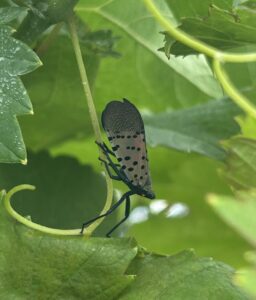
Figure 3. Spotted lanternfly adult in vineyards in south NJ.
Grape: The next timing for Grape Berry Moth will be on or about 7/22 if using Intrepid, Altacor or other diamides in southern counties. Growers using other insecticides can make applications a few days later. Spotted lanternfly adults are now being reported in vineyards in southern NJ (Figure 3).
Japanese beetles are actively feeding on foliage. Observations of downy mildew have increased from the previous week.
Blueberry: Treatments for spotted-wing drosophila should continue on a 7-day schedule. For management recommendations, refer to Commercial Blueberry Pest Control Recommendations for New Jersey. For weekly reports on blueberry pests and recommendations read the Rutgers Blueberry Bulletin.
Fruit IPM Report July 14, 2025
Peach:
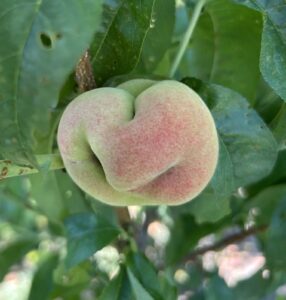
Figure 1. Early cat-facing injury on peach.
Brown rot: Most growers should be relying on a captan based program for mid-season covers, followed by better materials during the last 3 weeks pre-harvest. For reference see Dr. Norm Lalancette’s post Improving Your Late Season Peach Brown Rot Control Program — Plant & Pest Advisory.
Tarnished Plant Bugs; and Other Cat-facing Insects: Tarnished plant bug and stink bugs are active and present at moderate to high levels in some orchards. The percent fruit injury observed remains low (average <1%) but has increased from previous weeks (Figure 1).
Oriental Fruit Moth: A biofix point for OFM was set on 4/2 for southern counties and 4/17 in northern counties. See below for timings for third generation.
|
|||||||||||||||||||||||||
Scale Insects: Second generation White Peach Scale crawlers should emerge sometime this week or next. Second generation San Jose Scale crawlers emerge about 7/17 +/- 8 days. Esteem is a good scale material that has a 14-day PHI for stone fruit. Centaur is also effective, has a 14-day PHI and can be used only once during the growing season. Venerate has shown efficacy as a pre-harvest treatment against scale and has a 0-day PHI. If using Venerate to control scale insects, make 2 applications 7 days apart starting a week after crawler emergence.
Japanese Beetles: Japanese beetle activity has increased in orchards throughout the state. Products containing imidacloprid are standard insecticides for Japanese beetle control and have a short PHI. See the NJ Commercial Tree Fruit Production Guide for more information.
Apples and Pears:
Diseases: Now that primary scab has ended, the focus turns toward summer diseases such as fruit rots (esp. Bitter rot), and sooty blotch and fly speck. Bitter rot control has been difficult at best in recent years even where management programs have been rigorous. Research has suggested products such as Merivon, Luna Sensation, Inspire Super, Omega, and Aprovia may be effective, and longtime reliable broad-spectrum fungicides such as captan and ziram should provide control. Experience has suggested that the addition of phosphorous acid products such as Prophyt or Rampart to captan sprays may improve control. Observations are that these products improve control of other summer diseases such as sooty blotch and flyspeck, and may help suppress scab infections where present. Fungicides should be applied every 10-14 days, or consider reapplication after 2 inches of rainfall. Bitter rot symptoms have been observed in both southern and northern counties.
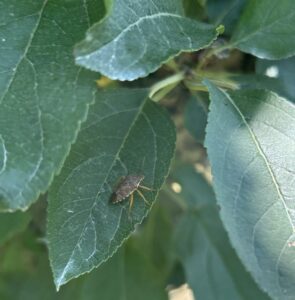
Figure 2. Adult Brown marmorated stink bug in apple.
Brown Marmorated Stink Bugs: Brown Marmorated Stink bugs are being captured at low levels in orchards statewide. Both adults and nymphs are present (Figure 2). See the NJ Tree Fruit Production guide for effective materials.
Codling Moth (CM): Second generation timings are updated below. Trap counts and emergence are low. Therefore, if you have applied your 2nd generation insecticides and your trap counts are low (less than 5 moths per trap), additional treatments are not needed.
| Codling Moth Degree Day Timing – Second Generation | ||||||||
| Application and Insecticide Type | ||||||||
| County Area | Biofix | Rimon:
75-100DD + 14-17 days later
|
Intrepid
1150 + 1450 DD Diamides – Altacor, Voliam mixes: (150-200 DD) |
Madex
1250 DD + every 7-9 days during brood hatch (later if first spray is an IGR) |
Standard Insecticides – Delegate, Avaunt, OP’s, carbamates, pyrethroids
1250 DD + 1550 DD
|
|||
| DD | 1150 | 1450 | 1250 | 1250 | 1550 | |||
| Southern | April 28 | N/A | N/A | past | past | past | past | past |
| Northern | April 30 | N/A | N/A | past | 7/14 | past | past | 7/17 |
Scale Insects: Second generation San Jose Scale should emerge about mid-July. Options include Esteem (2 applications/year; 45-day PHI); Centaur (1 application/year; 14-day PHI); Diazinon 50W (2 applications/year; 21-day PHI); Venerate (0-day PHI; Make two applications 7 days apart starting a week after crawler emergence).
Pear: Pear psylla nymphs have been observed in high numbers feeding on new growth in some orchards. Options for control include Movento (IRAC group 23), spinosyn products such as Delegate (IRAC group 5), and the neonicotinoids (IRAC group 4A).
Phenology Table: Based on annual observations made in Gloucester County.
| Pest Event or Growth Stage | Approximate Date | 2025 Observed Date |
| Bud Swell (Redhaven/PF-17) | March 23 +/- 15 Days | March 30 |
| 1/4″ Green Tip Red Delicious | March 31 +/- 13 Days | March 30 |
| Pink Peach (Redhaven/PF-17) | April 4 +/- 15 Days | April 1 |
| Tight Cluster Red Delicious | April 9 +/- 13 Days | April 5 |
| Full Bloom Peach (Redhaven/PF-17) | April 9 +/- 14 Days | April 10 |
| Pink Apple (Red Delicious) | April 14 +/- 12 Days | April 16 |
| Full Bloom Apple (Red Delicious) | April 22 +/- 11 Days | April 25 |
| Petal Fall (Redhaven) | April 22 +/- 10 Days | April 19 |
| Petal Fall (Red Delicious) | April 27 +/- 13 Days | May 2 |
| Shuck Split (Redhaven) | April 30 +/- 11 Days | April 26 |
| Pit Hardening | June 15 +/- 9 Days | June 15 |
Tree Fruit Trap Captures – Southern Counties
| Week Ending | STLM | TABM-A | CM | BMSB | OFM-A | DWB | OFM-P | TABM-P | LPTB | PTB |
| 4/5/2025 | 0 | 0 | 0 | 0 | 0 | 0 | 0 | 0 | 0 | 0 |
| 4/12/2025 | 0 | 0 | 0 | 0 | 6 | 0 | 0 | 0 | 0 | 0 |
| 4/21/2025 | 0 | 0 | 0 | 0 | 36 | 0 | 1 | 0 | 0 | 0 |
| 4/27/2025 | 25 | 0 | 0 | 0 | 24 | 0 | 5 | 0 | 1 | 0 |
| 5/2/2025 | 517 | 0 | 4 | 0 | 12 | 0 | 6 | 0 | 13 | 0 |
| 5/9/2025 | 159 | 4 | 10 | 0 | 3 | 16 | 5 | 4 | 46 | 0 |
| 5/16/2025 | 91 | 11 | 6 | 0 | 1 | 36 | 2 | 14 | 69 | 0 |
| 5/23/2025 | 299 | 21 | 3 | 0 | 1 | 23 | 1 | 26 | 23 | 0 |
| 5/30/2025 | 399 | 14 | 2 | 0 | 0 | 41 | 1 | 11 | 10 | 3 |
| 6/6/2025 | 733 | 13 | 1 | 0 | 0 | 36 | 2 | 12 | 29 | 1 |
| 6/13/2025 | 684 | 19 | 2 | 1 | 0 | 81 | 2 | 17 | 22 | 8 |
| 6/20/2025 | 724 | 24 | 2 | 0.5 | 1 | 60 | 1 | 23 | 19 | 12 |
| 6/27/2025 | 932 | 5 | 1 | 0.8 | 1 | 40 | 0 | 5 | 24 | 14 |
| 7/4/2025 | 643 | 0 | 0 | 0.75 | 1 | 17 | 0 | 0 | 6 | 16 |
| 7/11/2025 | 194 | 0 | 0 | 0.5 | 0 | 18 | 8 | 0 | 24 | 0 |
Tree Fruit Trap Captures – Northern Counties
| Week Ending | STLM | TABM-A | CM | BMSB | OFM-A | DWB | OFM-P | TABM-P | LPTB | PTB | AMBROSIA BEETLE |
| 4/5/2025 | 387 | 0 | 0 | 0 | 0 | 0 | 0 | 0 | 0 | 0 | 0 |
| 4/21/2025 | 435 | 0 | 0 | 0 | 0 | 0 | 1.3 | 0 | 0 | 0 | 0 |
| 4/27/2025 | 26 | 0 | 0 | 0 | 0 | 0 | 25 | 0 | 0 | 0 | 72 |
| 5/2/2025 | 86 | 0 | 0.33 | 0 | 72.5 | 0 | 47.2 | 0 | 0 | 0 | 136 |
| 5/9/2025 | 56 | 0 | 5.3 | 0 | 58.8 | 0 | 22.9 | 0 | 0 | 0 | 145 |
| 5/16/2025 | 13.75 | 2.6 | 7.3 | 0 | 4 | 0 | 5 | 0 | 0 | 0 | 50.5 |
| 5/23/2025 | 4.8 | 10.3 | 10.5 | 0 | 0.6 | 31.25 | 4.2 | 0 | 14.6 | 1 | 22.2 |
| 5/30/2025 | 2.2 | 4.8 | 1.8 | 0 | 0 | 12.4 | 9.6 | 0 | 9.6 | 1.9 | 22.1 |
| 6/6/2025 | 3 | 4.83 | 2.8 | 0.25 | 0 | 20 | 4.1 | 0 | 21.2 | 1.8 | 40.3 |
| 6/13/2025 | 65 | 20 | 11.4 | 0.6 | 0 | 12.3 | 4 | 0 | 10.5 | 1.5 | 59.2 |
| 6/20/2025 | 26 | 26 | 8 | 0.75 | 1 | 13 | 4.5 | 0 | 11 | 0.75 | 52 |
| 6/27/2025 | 145 | 19 | 6 | 1.3 | 6 | 35 | 5.4 | 0 | 16 | 1.6 | 38 |
| 7/4/2025 | 212 | 6 | 3 | 0.6 | 12.5 | 40 | 2 | 0 | 8.4 | 1.1 | 27 |
| 7/11/2025 | 125 | 2.5 | 0.5 | 0.14 | 5 | 41 | 3 | 0 | 20 | 4.5 | 48 |
Grape: The next timing for Grape Berry Moth will be on or about 7/22 for Intrepid or Diamides, or a few days later for other insecticides based on the biofix of May 19 in southern counties.
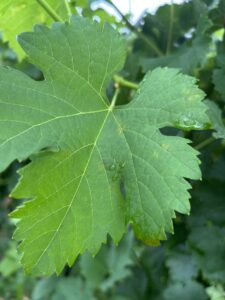
Figure 3. Downy mildew on grape.
Treatments for the third generation are at an accumulation of 1620 degree days (base 47.14). Spotted lanternfly adults were reported last week in vineyards in southern NJ. See this previous Plant & Pest Advisory post on Management of Spotted Lanternfly in New Jersey Vineyards. Also, Japanese beetle pressure is increasing in vineyards throughout the state. See the NJ Commercial Grape Production Guide for more information on insecticides effective for JB.
Diseases: Wet, warm and humid weather has been conducive for infections from Downy mildew. Dr. Mizuho Nita at Virginia Tech provides a comprehensive update and summary of diseases from bloom to harvest.
Blueberry: Spotted-wing drosophila (SWD) numbers have increased from previous weeks. Treatments for spotted-wing drosophila should continue on a 7-day schedule. For management recommendations, refer to Commercial Blueberry Pest Control Recommendations for New Jersey. For weekly reports on blueberry pests and recommendations read the Rutgers Blueberry Bulletin.
Early July Peach Varieties – Sentry, Glenglo, Ruby Prince, Garnet Beauty, and Sugar May
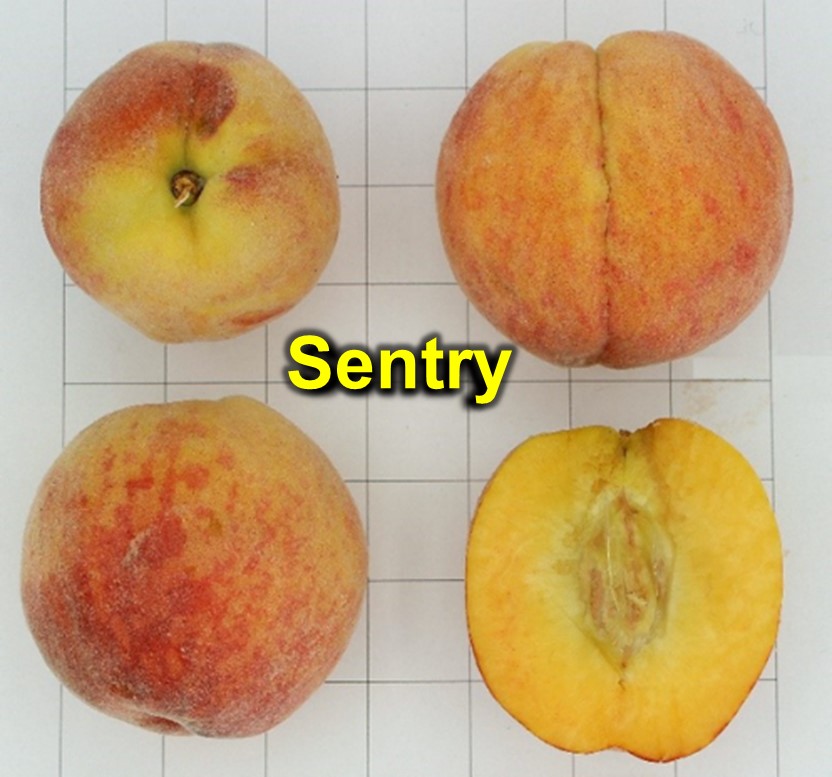 Warmer temperatures and periodic rains in the last few weeks helped early July peach varieties achieve a bigger size. There are excellent peach varieties throughout the harvest season; however, each has a few challenges, and understanding the overall tree and fruit characteristics can help make thinning, harvest, disease management, and post-harvest decisions. The Newer varieties were also compared against standard varieties. Understanding these differences is essential for selecting new varieties or replacing existing ones. Note that these varieties were evaluated in southern New Jersey; as a result, the harvest dates could be a few days later for the Central and Northern New Jersey orchards.
Warmer temperatures and periodic rains in the last few weeks helped early July peach varieties achieve a bigger size. There are excellent peach varieties throughout the harvest season; however, each has a few challenges, and understanding the overall tree and fruit characteristics can help make thinning, harvest, disease management, and post-harvest decisions. The Newer varieties were also compared against standard varieties. Understanding these differences is essential for selecting new varieties or replacing existing ones. Note that these varieties were evaluated in southern New Jersey; as a result, the harvest dates could be a few days later for the Central and Northern New Jersey orchards.
Sentry: It’s a medium-large to large, red over green-yellow ground-colored peach that ripens during the first week of July. The flesh is moderately firm, very sweet, and mildly tangy (Total Soluble Solids (TSS) 11.32 Brix and Titratable Acidity (TA) 2.08 g/l). It is one of the sweeter varieties in this harvest window. In general, the TSS greater than 11 Brix is considered very sweet. It can get bigger up to 3 inches in diameter, however, at the cost of firmness. It has low susceptibility to the bacterial spot.
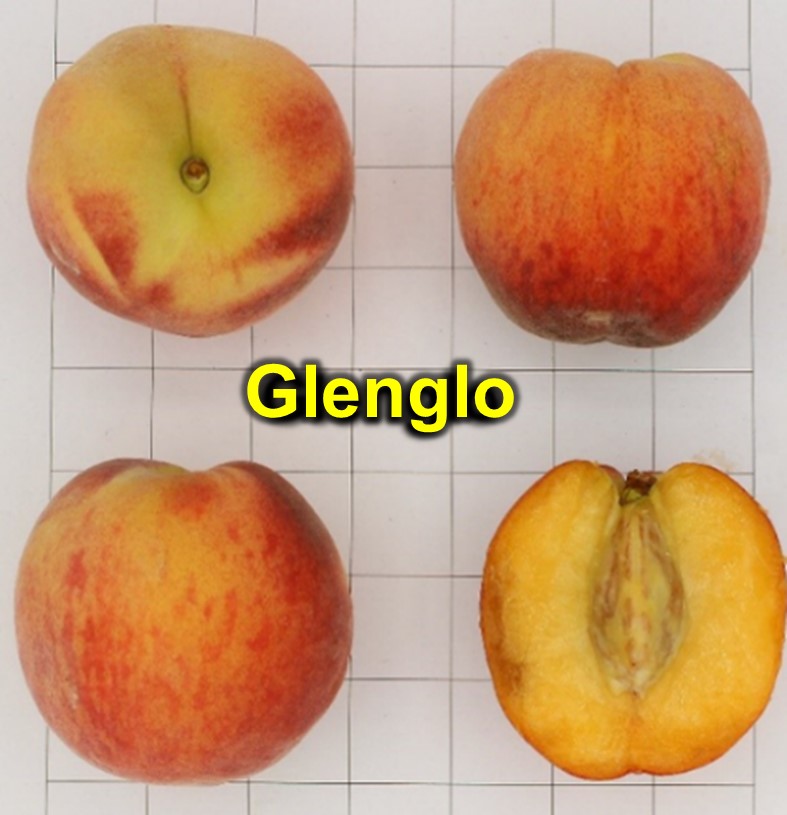 Challenges: The main challenge is that fruit has a variable cropping record, but growers prefer it because of its size and taste. Also, a green-yellow background color may give the impression of unripe fruit. Some growers have noticed that older trees of Sentry produced unevenly ripened fruit where one end of the tip was softer while the other end was much firmer. Bigger fruits tend to split. The general recommendation is to avoid letting fruit get bigger than 2 ¾ inches till the Redhaven season.
Challenges: The main challenge is that fruit has a variable cropping record, but growers prefer it because of its size and taste. Also, a green-yellow background color may give the impression of unripe fruit. Some growers have noticed that older trees of Sentry produced unevenly ripened fruit where one end of the tip was softer while the other end was much firmer. Bigger fruits tend to split. The general recommendation is to avoid letting fruit get bigger than 2 ¾ inches till the Redhaven season.
Glenglo: It’s an attractive yellow-fleshed peach that gets harvested a few days after ‘Sentry’. In some years, it gets harvested before Sentry or overlaps with Sentry. The fruit is medium-large in size, sweet, acidic, and mildly tangy (TSS 11 Brix; and TA 2.5 g/l). It has low susceptibility to bacterial Spot. The cold-hardiness is better than Sentry’s. Glenglo is comparable to Sentry; however, it does not have the problem of uneven ripening. It is considered worthy of replacing “Sentry.
Ruby Prince: It’s a medium-large, globose, and attractive semi-clingstone yellow-fleshed peach variety that ripens a few days after Sentry and Glenglo. The flesh is moderately firm with a sweet and mildly tangy flavor. The scarlet-red over yellow skin color and uniform shape of fruit makes it very attractive variety. It is a worthy replacement of ‘Sentry’. The flesh has greater traces of red. Fruit size is medium to large and uniform.
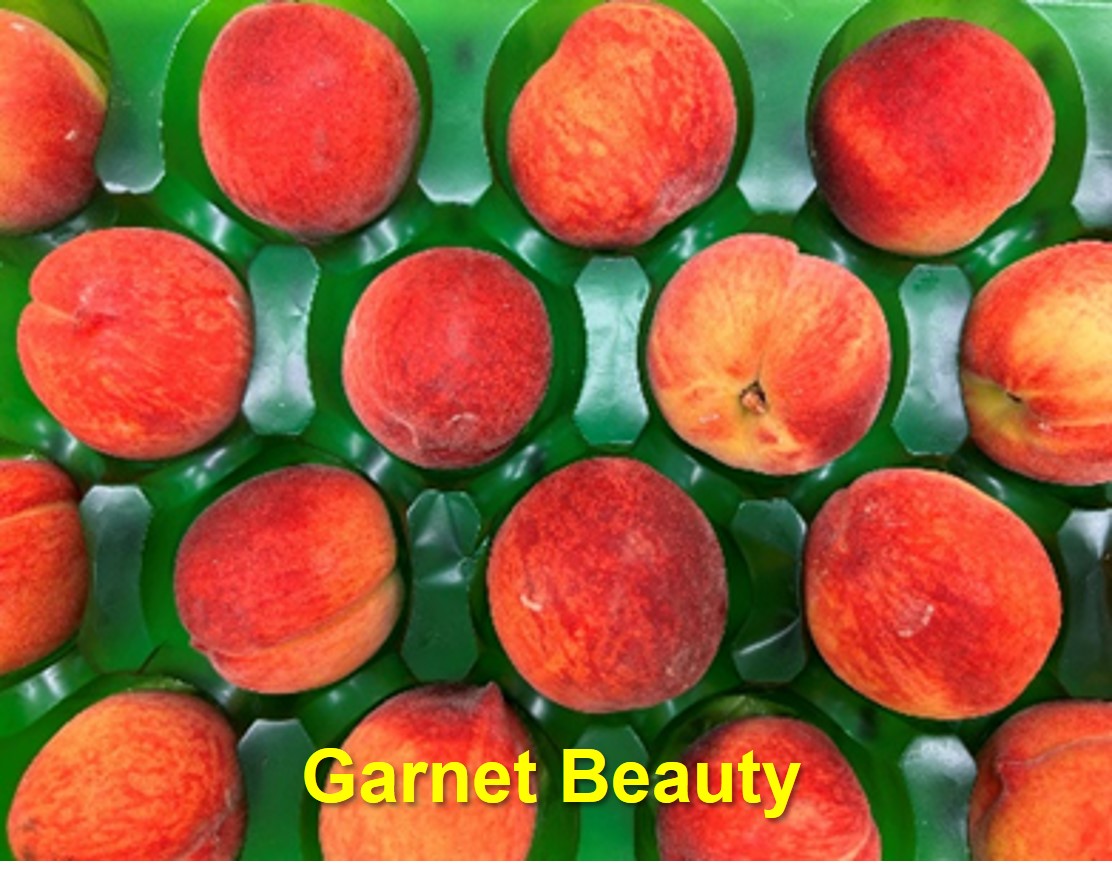 Garnet Beauty is a sport of Redhaven, ripening about 12-14 days earlier. Yellow-fleshed, clingstone, medium-sized peach, relatively hardy with 40-60% red blush. Fruit is high quality, firm, and freestone when fully ripe. The fruit has a prominent suture groove. The tree is vigorous and productive. The flavor is not great compared to other varieties this season.
Garnet Beauty is a sport of Redhaven, ripening about 12-14 days earlier. Yellow-fleshed, clingstone, medium-sized peach, relatively hardy with 40-60% red blush. Fruit is high quality, firm, and freestone when fully ripe. The fruit has a prominent suture groove. The tree is vigorous and productive. The flavor is not great compared to other varieties this season.
Other yellow-fleshed peach varieties: Flaming Fury PF7 is a medium to medium-large, semi-freestone yellow-fleshed peach that ripens during the Glenglo season. This is a good-yielding peach variety; however, most other varieties have better sizes.
White-fleshed Peach Varieties.
Sugar May is a firm, white-fleshed, clingstone peach ripening around July 7. dark red to purplish red skin color. The flavor is good, but acidic. The tree is vigorous and productive but susceptible to bacterial spot.
Challenges: For the white fleshed peach, it is a little too acidic, and some consumers’ expects white peaches in general to be very sweet and sub-acid. Skin is dark red, so one must bite to determine if it has ripened. The core stays greenish-yellow. As seen in the photo, the first superficial (right) bite has cream flesh; however, the slightly deeper (left) bite has greenish flesh. Also, it is moderately susceptible to bacterial spot.
Rutgers to Host Afternoon Cover Crops Field Day – August 5
Rutgers Cover Crops Field Day
*The program may be rescheduled in the event of inclement weather*
Date: August 5, 2025
Time: 3:00PM to 6:00 PM
Where: Snyder Research Farm, 140 Locust Grove Rd, Pittstown, NJ 08867
REGISTRATION REQUIRED:
Please register by calling RCE of Sussex County: 973-948-3040
*First 20 registrants will receive a FREE copy of the USDA SARE book: “Managing Cover Crops Profitably”
This event will highlight several cover crop research projects and foster discussion and networking on drone use in agriculture and cover crop management.
Please join us for this summer event.
We will also discuss an upcoming drone pilot certification training we will be hosting this winter.
3:00 PM Registration and Welcome – Stephen Komar, ANR Agent /Rutgers SARE Coordinator
3:15 PM Go to the Field – Calibrating a Drone for Agricultural Applications – Adam Kyle, Warren Co. Com. College, Teaching Administrator, Precision Agriculture, Stephen Komar
4:00 PM Summer Cover Crop Planting Comparison: Drone vs. Drill – Bill Bamka, ANR Agent
4:30 PM Row Middle Cover Crops vs Herbicides for Weed Management in Vegetable Culture – Kate Brown, ANR Agent
RC&D Cover Crop Programs- Laura Tessieri, Executive Director, North Jersey RC&D
Drone Seeding Cover Crops into Pumpkins – Peter Nitzsche, ANR Agent
5:30 PM Update on Worker Protection Standards and Pesticide Recordkeeping – Michelle Infante-Casella, ANR Agent
6:00 PM Pesticide Credits and Adjourn
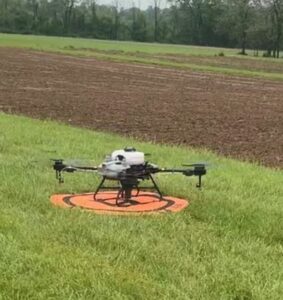
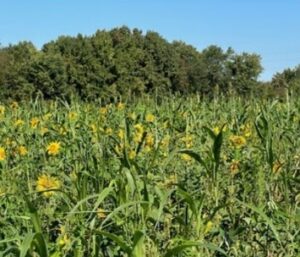
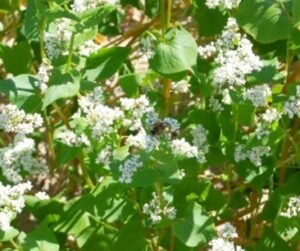
This event is sponsored by a grant awarded to Stephen Komar (Principal Investigator), Michelle Infante-Casella, and William Bamka Agricultural Agents/Professors, Rutgers Cooperative Extension, by the USDA, Sustainable Agriculture Research and Education, Professional Development Program.


